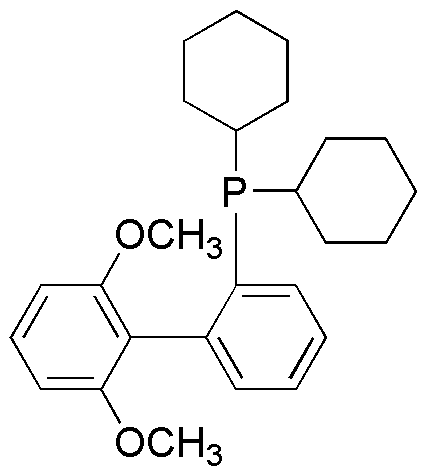Dicyclohexyl[2-(2,6-dimethoxyphenyl)phenyl]phosphane is widely utilized in research focused on:
- Catalysis: This compound serves as an effective ligand in various catalytic reactions, enhancing the efficiency of chemical transformations in organic synthesis.
- Pharmaceutical Development: It plays a crucial role in the design of new pharmaceuticals, particularly in the development of compounds that target specific biological pathways.
- Material Science: Utilized in the creation of advanced materials, it contributes to the development of polymers and composites with improved properties.
- Environmental Chemistry: The compound is applied in studies aimed at understanding and mitigating environmental pollutants, offering insights into remediation strategies.
- Analytical Chemistry: It is used in the formulation of reagents for analytical techniques, facilitating the detection and quantification of various substances in complex mixtures.
General Information
Properties
Safety and Regulations
Applications
Dicyclohexyl[2-(2,6-dimethoxyphenyl)phenyl]phosphane is widely utilized in research focused on:
- Catalysis: This compound serves as an effective ligand in various catalytic reactions, enhancing the efficiency of chemical transformations in organic synthesis.
- Pharmaceutical Development: It plays a crucial role in the design of new pharmaceuticals, particularly in the development of compounds that target specific biological pathways.
- Material Science: Utilized in the creation of advanced materials, it contributes to the development of polymers and composites with improved properties.
- Environmental Chemistry: The compound is applied in studies aimed at understanding and mitigating environmental pollutants, offering insights into remediation strategies.
- Analytical Chemistry: It is used in the formulation of reagents for analytical techniques, facilitating the detection and quantification of various substances in complex mixtures.
Documents
Safety Data Sheets (SDS)
The SDS provides comprehensive safety information on handling, storage, and disposal of the product.
Product Specification (PS)
The PS provides a comprehensive breakdown of the product’s properties, including chemical composition, physical state, purity, and storage requirements. It also details acceptable quality ranges and the product's intended applications.
Certificates of Analysis (COA)
Search for Certificates of Analysis (COA) by entering the products Lot Number. Lot and Batch Numbers can be found on a product’s label following the words ‘Lot’ or ‘Batch’.
Número de catálogo
Número de lote/lote
Certificates Of Origin (COO)
This COO confirms the country where the product was manufactured, and also details the materials and components used in it and whether it is derived from natural, synthetic, or other specific sources. This certificate may be required for customs, trade, and regulatory compliance.
Número de catálogo
Número de lote/lote
Safety Data Sheets (SDS)
The SDS provides comprehensive safety information on handling, storage, and disposal of the product.
DownloadProduct Specification (PS)
The PS provides a comprehensive breakdown of the product’s properties, including chemical composition, physical state, purity, and storage requirements. It also details acceptable quality ranges and the product's intended applications.
DownloadCertificates of Analysis (COA)
Search for Certificates of Analysis (COA) by entering the products Lot Number. Lot and Batch Numbers can be found on a product’s label following the words ‘Lot’ or ‘Batch’.
Número de catálogo
Número de lote/lote
Certificates Of Origin (COO)
This COO confirms the country where the product was manufactured, and also details the materials and components used in it and whether it is derived from natural, synthetic, or other specific sources. This certificate may be required for customs, trade, and regulatory compliance.


